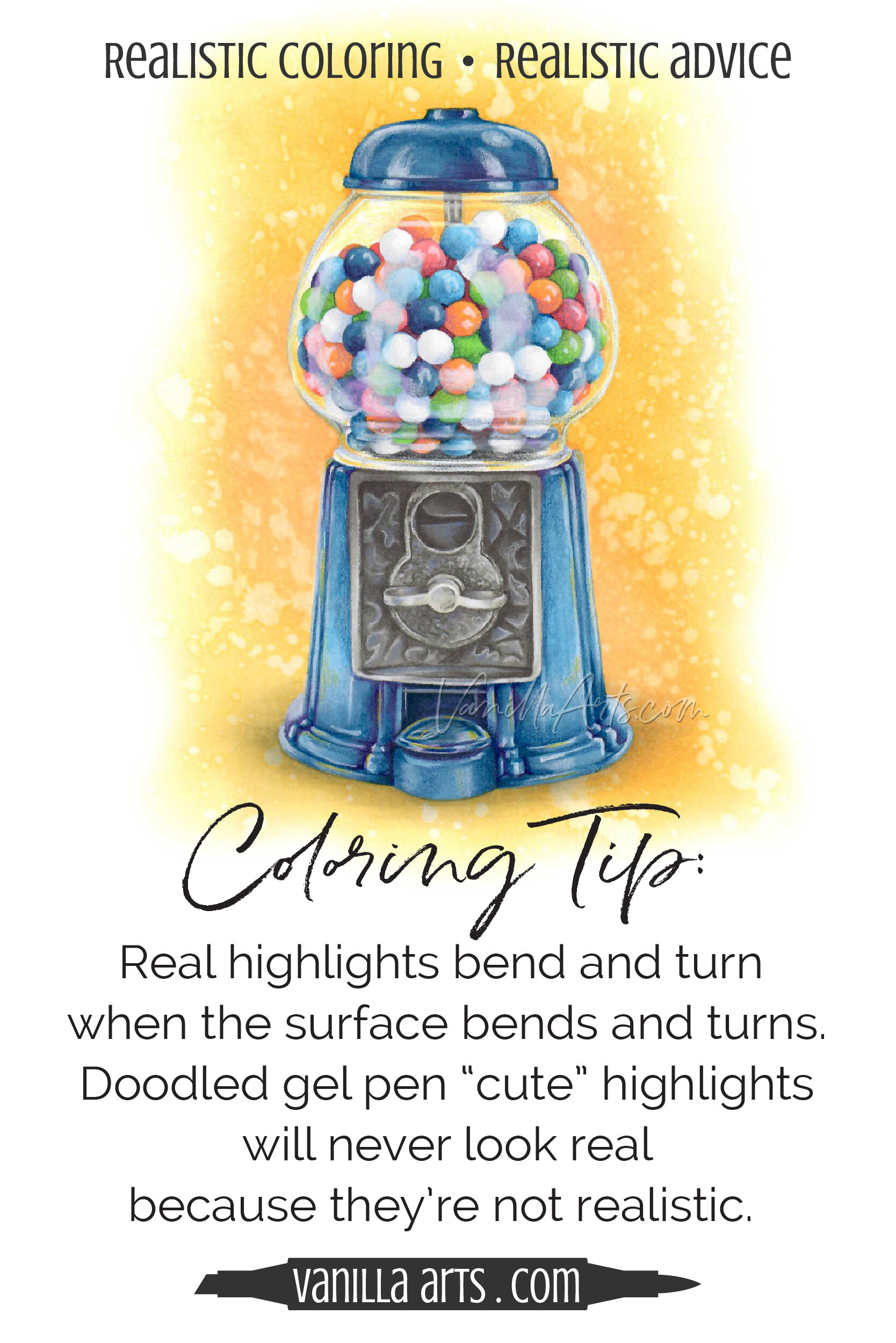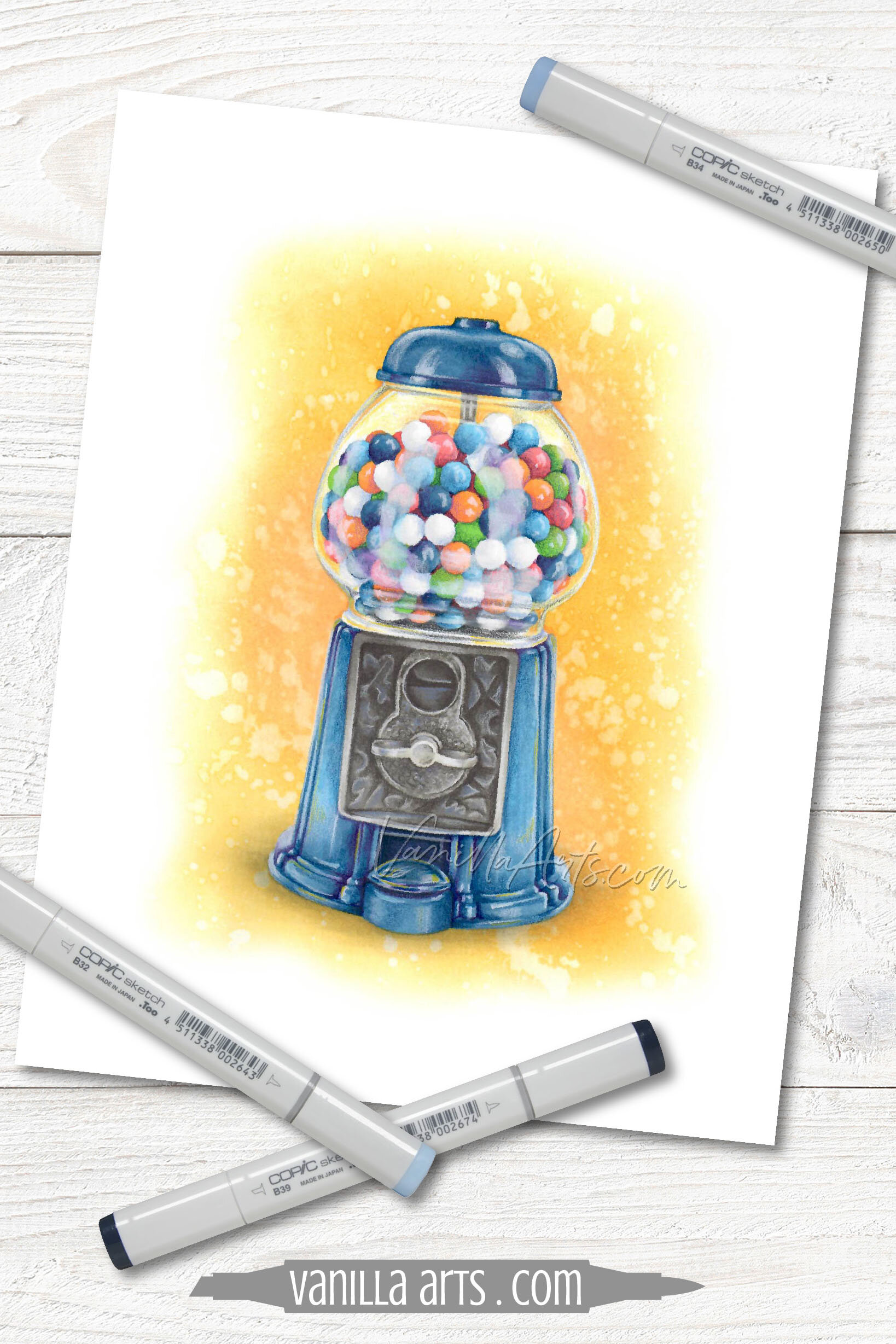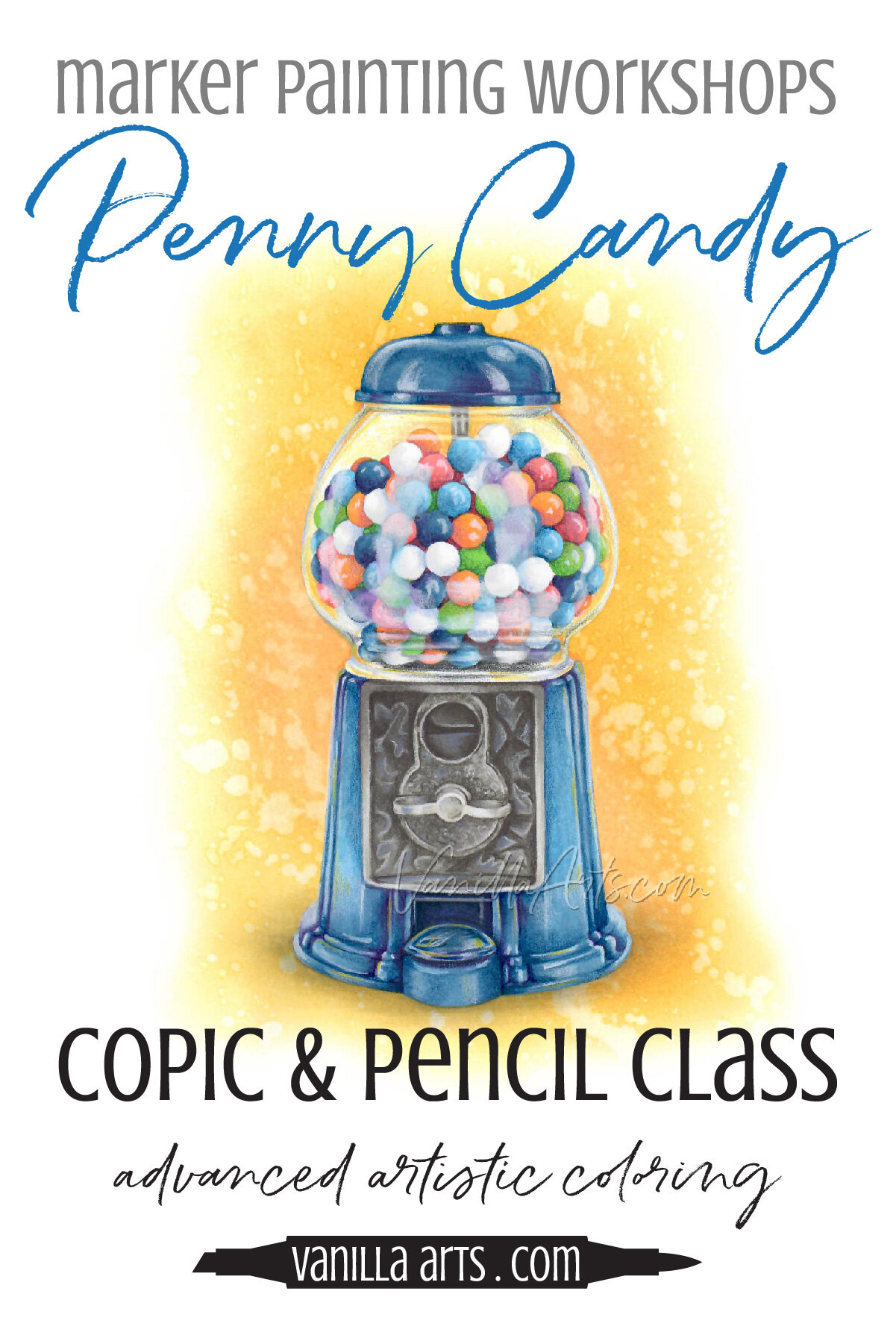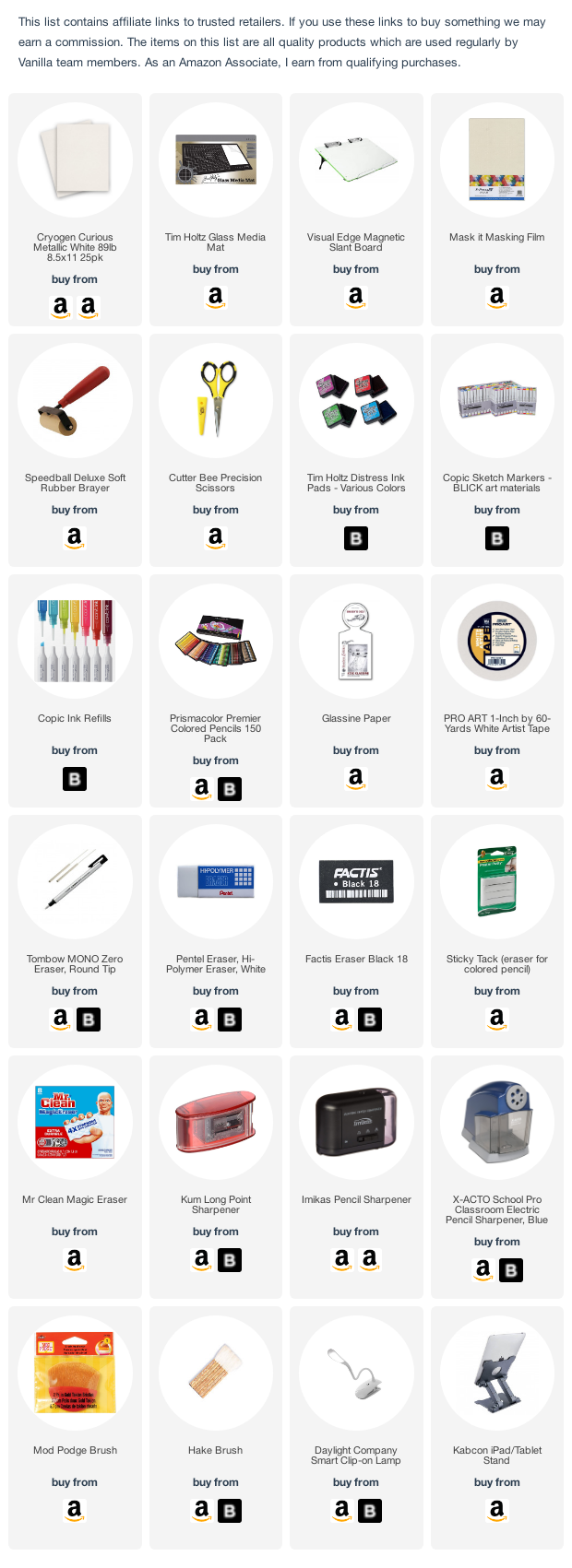Coloring Tip: How to Color Realistic Highlights (Copic Marker, Colored Pencil)
Coloring Tip: To color realistic highlights, skip the gel pen in favor of an artist-grade translucent white colored pencil. Highlights mimic the shape of the surface and are not as white as you think. Professional illustrator Amy Shulke explains the full process plus tips in detail here.
Realistic Highlights Make Realistic Coloring
You want to get more depth, dimension, and realism from your Copic Markers and colored pencils.
So you spend a ton of time picking just the right colors…
And you labor over getting all the right shade colors into just the right spots…
You work hard to get all the details just right…
And you try to duplicate the texture exactly…
It’s looking great! You’re coloring with realism!
Then you grab a white gel pen and decorate the heck out of it with dots, lines, and semi-colon shapes.
Because that’s what highlights look like???
Stop.
Put the bleepin’ gel pen down.
Today, let’s look at how to color realistic highlights for more realistic coloring.
Read more about realistic coloring here:
white gel pens will never make realistic looking highlights
I don’t care what you were taught.
I don’t care what the tutorials say.
Using a white gel pen to add highlights and shine is a method used by crafters and cartoonists.
It will never look real because it was never intended to look real.
First of all, I’ve never seen a real highlight that looks like a semi-colon.
I don’t know why people always draw semi colons. Semi colons are for punctuation, not photo realistic coloring.
But even if you’re more of a morse code kind of person, dot dot dash or dash dash dot… what you’re doing is a stylized version of a stylized technique used for stylized illustrations.
PRO TIP: if someone says “cute highlights”, that’s a sign they look fake.
The other problem is that white gel pen is white.
Really, really white.
And highlights? Not so much.
Real highlights are a lighter version of the base color. They may have areas of strong brightness but for the most part, highlights on a blue gumball machine are blue, not white.
You look at a lot of coloring, a lot of cards, coloring books, or manga… it’s all other people’s artwork. We’re so far removed from actual highlights that most of us have forgotten what real highlights look like.
If you’re going to color with realism, shouldn’t you be looking at and recreating real highlights?
And that’s the root of the problem: Most people color the idea of a highlight rather than actual highlights.
Understand the highlight before you color the highlight
Ya’ gotta understand it right before you can color it, right?
The key to figuring out highlights is to always remember that a highlight sits on the surface of an object.
In the case of this gumball machine, we’ve got lots of highlights everywhere. But for simplicity, let’s focus on the blue top cap of the machine.
The highlights are sitting directly on the blue enamel paint. They’re not part of the paint but they’re essentially a top layer of gloss.
When you explore shapes in photo references, you’ll find the highlight is your guide to the object’s topography (the surface shape).
Highlights are easy to see, so we tend to see them first. Highlights give us clues to how the surface is shaped.
Down at the bottom edge of the cap, there’s a lip which makes a 90 degree turn. The highlight makes that sharp turn too. As our eye travels up the side of the cap, the surface makes a convex bend and so does the highlight. Up at the top, there’s a flat plain and the highlight flattens there too. Then there’s an upward concave bend and the highlight turns with it.
For everything the cap’s surface does, the highlight follows the same shape.
There’s a wonderful logic to it.
You’ll see the same thing happen with everything from apples to zebras, the highlight always mimics the surface topography because it’s part of the surface.
How to Color Realistic Highlights
To create realistic highlights, you need two tools: a photo reference and a translucent white pencil.
You need the photo reference because otherwise, you’re just guessing.
Don’t be a guesser. People who guess end up making semi colon shapes.
Explore your photo reference the same way we just did with the gumball machine cap. Learn about your object before you color the highlights.
Most people have no issues finding the bright white hard-edged highlights. Artists call these hot-spots.
But did you catch the softer, diffused highlight around the base of the top-knob?
I like to visually scan a photo throughly by moving my eye horizontally, from left to right, then right to left, row by row, gradually up the object.
Then I do the same thing but opposite poles, this time scanning top to bottom, zig-zagging vertically across the image. By going left-right, then top-bottom, I won’t miss the soft subtle lights which don’t pop as much as hot spots.
Lastly, I revisit each highlight and let my eye explore the shape and color of it, getting to know each light and it’s unique personality.
After the visual exploration, you’ll want a white or light colored pencil, perhaps a lighter version of your base color (in this case, blue).
I really like Prismacolor Premier White pencils (PC938) because with a light pressure, I can create very soft, barely-there highlights, but with the same pencil and more pressure, I can get a stronger, brighter, crisper white. Holbein makes an excellent White pencil too (OP500) as does Luminance (White 001 or Buff Titanium 801)
Colored Pencil also sinks into the surface of the paper in the first few days, in this case allowing the highlights on the blue enamel to gradually soften and get a little bluer overnight.
I do not like to color highlights with marker because to create a bright spot, you have to reserve and preserve(!) both the color and the shape of the highlight throughout the entire blending process. It can be done, but dang, it’s difficult. More often than not, marker highlights end up looking too small, the wrong color, or the wrong shape.
With the pencil, using a circular stroke and an extremely light, light, light pressure, I slowly start to create a gentle cloud in the shape of the light spot.
DO NOT DRAW OR OUTLINE THE SHAPE WITH YOUR PENCIL!
This is the biggest mistake people make, they think that by lightly drawing the shape, they can maybe change their minds and redraw it larger or erase and start over.
Drawing leads to heartache!
I can’t warn you strongly enough not to draw the shape! When you draw, unless you’re very experienced at drawing, you’ll press much harder than you intend. This creates a crisp outline on the highlight when what we really want is a soft fade with no distinctive edge.
I use an ultra-soft circular stroke and start in the center of where I want the highlight. I circle around a few times to start the color, then I begin to branch out and expand the shape. Growing it gradually allows you to correct the shape and the strength of the color without ever creating a harsh outline.
The beauty of using a good quality colored pencil is that you can come back to add more color where you need more brightness or whiteness.
Build your highlight gradually with several layers rather than scrubbing it on in one shot.
Never increase the pressure, simply add another layer to increase the white value.
The most important thing to keep in mind is that realistic highlighting is a learning process.
The more you do it, the easier it gets and the better it looks.
So if you try it once and it doesn’t look amazing, don’t give up.
My highlights used to stink but now with lots of practice, I barely even think about the process. You’ll get there too!
The color of Realism
Never be limited by your photo references again!
Ready to try challenge level coloring?
Penny Candy an Advanced level Marker Painting Workshop
Learn to understand color as value. Amy offers an in-depth lesson on how to alter the color of your photo references without sacrificing realism.
Real time coloring, recorded live
Live Workshops are unscripted demonstrations which provide students with a real look into the authentic coloring process. You’ll see mistakes being made and corrected. It’s just like visiting Amy in her home studio.
Log in and color with Amy at your convenience. Anytime access, no expiration dates.
Class was recorded in May 2021 and featured a live student audience. Amy answers questions from the students and offers many tips for better colored pencil art.
Select supplies used in Penny Candy:
Vanilla Arts Company is a participant in the Amazon Services LLC Associates Program, an affiliate advertising program designed to provide a means for use to earn fees by linking to Amazon.com.
















